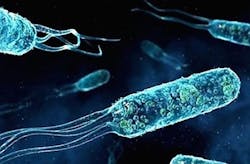The U.S. military is using genetic engineering to alter life forms to detect enemy submarines
The Military & Aerospace Electronics take:
4 Dec. 2018 -- It’s one of many potential military applications for so-called engineered organisms, a field that promises living camouflage that reacts to its surroundings to better avoid detection, new drugs and medicines to help deployed forces survive in harsh conditions, and more. But the research is in its very early stages, military officials said.
Here’s how it would work: You take an abundant sea organism, like Marinobacter, and use genetic engineering to change its genetic makeup to react to certain substances left by enemy vessels, divers, or equipment. These could be metals, fuel exhaust, human DNA, or some molecule that’s not found naturally in the ocean but is associated with, say, diesel-powered submarines. The reaction could take the form of electron loss, which could be detectable to friendly sub drones.
“In an engineered context, we might take the ability of the microbes to give up electrons, then use [those electrons] to talk to something like an autonomous vehicle. Then you can start imagining that you can create an electrical signal when the bacteria encounters some molecule in their environment,” NRL researcher Sarah Glaven said at a November event put on by the Johns Hopkins University’s Applied Physics Lab.
Related: Raytheon BBN to tap into sea life to help detect and track enemy submarines and UUVs
Related: Navy places order for 166,500 anti-submarine warfare (ASW) sonobuoys in $219.8 million deal
John Keller, chief editor
Military & Aerospace Electronics
Ready to make a purchase? Search the Military & Aerospace Electronics Buyer's Guide for companies, new products, press releases, and videos
